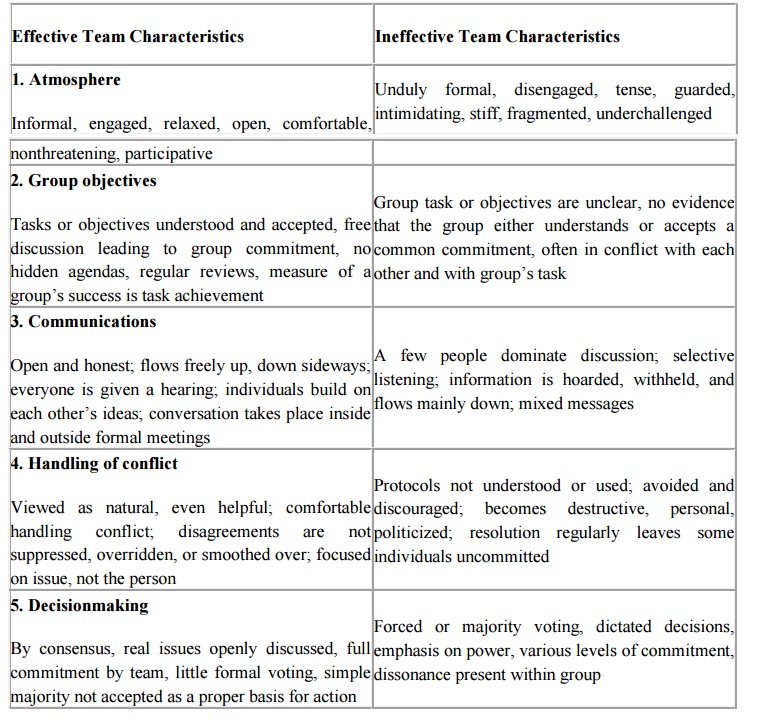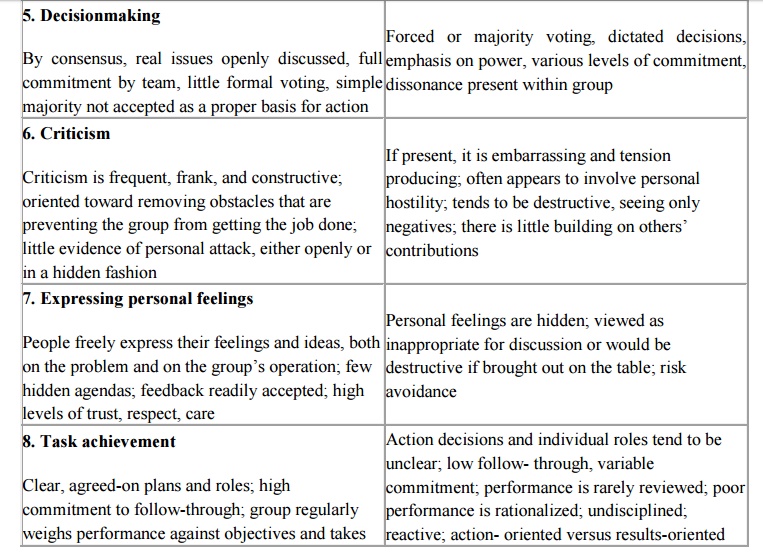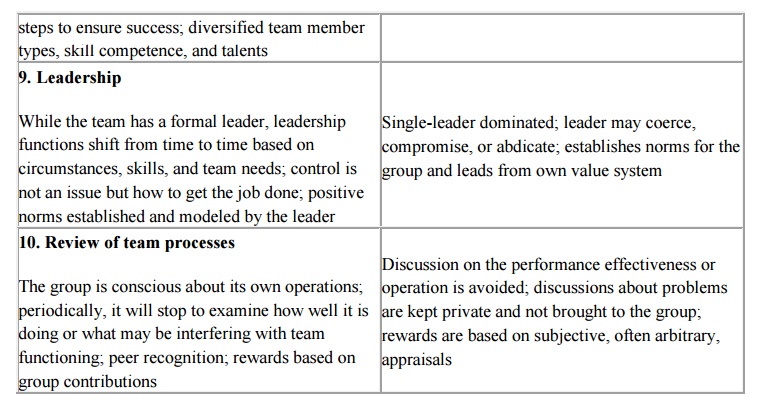Chapter: Business Science : Managerial Behavior and Effectiveness : Defining The Managerial Job
Defining the Managerial Job
DEFINING THE MANAGERIAL JOB
1 Managerial Job-Descriptive Dimensions
2 Methods of Managerial job dimensions
3 Model of Managerial dimensions
4 Time Dimensions in Managerial Jobs
5 Effective and Ineffective Job behavior
6 Functional and level differences in Managerial Job behavior
MANAGEMENT
According to Peter Drucker, Management implies ‗Effectiveness‘ and effectiveness involves a set of practices that can be learned. Such practices include:
• Management of time
• Focusing on employees and customers
• Building on strengths
• Identifying priorities
• Making effective decisions
According to Peter Drucker, Management implies ‗Effectiveness‘ and effectiveness involves a set of practices that can be learned. Such practices include: • Management of time • Focusing on employees and customers • Building on strengths • Identifying priorities • Making effective decisions
1 Managerial Job-Descriptive Dimensions
General Functions of a Manager
1. General Functions of a Manager
Planning - plans to integrate and coordinate activities.
Organizing- includes the determination of what tasks are to be done, how the tasks are to be grouped, who reports to whom and where the decisions are to be made.
Leading - management‘s job to direct and coordinate people. When managers motivate subordinates, direct the activities of others, select the most effective communication channel, or resolve conflicts among members.
Controlling - To ensure that things are going, as they should, management must monitor the organization‘s performance.
Functional Dimensions: Henri Fayol
The other activities of a business enterprise that managers perform, according to Fayol, could be divided into six categories:
1. Technical (Production, Manufacturing)
2. Commercial (Buying, Selling, Exchanging)
3. Financial (Obtaining and using capital)
4. Security (Protecting of property and persons)
5. Accounting (Balance sheet, stock taking, statistics, costing)
6. Managerial (Planning, Organizing, Commanding, Co-coordinating, Control)
2 Methods of Managerial job dimensions
Heuristic methods of Managerial Behavior & Performance
The person
Qualities include
ü Ability to sustain defeat Alert
ü Ambitious Assertive
ü Capable of good judgment Confident
ü Competitive Creative
ü Decisive Dedicated
ü Defensive Dynamism
ü Emotional stability Energetic
ü Extrovert Fear of failure
ü Group oriented Honest
ü Intelligent Mentally strong
ü Optimistic Pragmatic
ü Predictable Realistic
ü Self-controlled Tolerant
The process
• Answers how managers manage successfully
• Manage work instead of people
• Plan and organize effectively
• Set goals realistically
• Decisions based on consensus but accept responsibility
• Delegate frequently and effectively
• Rely on others to help solve problems
• Communicate precisely
• Cooperate with others
• Display consistent and dependable behavior
• Win with grace
• Express hostility tactfully
Product
These reflect on outcome of effective managing and include:
• Organizational efficiency
• High productivity
• Profit maximization
• Organizational stability
• Employee welfare
• Social welfare
The four greatest myths are:
1. Task-oriented skills are more important for leadership effectiveness than ar person oriented skills.
2. Male managers are more likely to possess task oriented abilities than are female managers; whereas female managers are more likely to possess person oriented skills than are male managers.
3. In order to maximize managerial effectiveness, men should be given the jobs that require task-oriented abilities and women should be given the jobs that require interpersonal skills.
4. If women want to rise to the top levels of management, they need to be more like men.
MYTH#1: Task-oriented skills are more important for leadership effectiveness than are person-oriented skills.
MYTH#2: Male managers are more likely to possess task-oriented abilities than are female mangers, whereas female managers are more likely to possess person-oriented skills than are male managers.
MYTH#3: In order to maximize managerial effectiveness, men should be given the jobs that require task-oriented abilities and women should be given the jobs that require interpersonal skills.
MYTH#4: If women want to rise to the top levels of management, they need to be more like men.
Benefits of Androgynous Management
Luthans description of effective and successful managers:
Fred Luthans and his associates studied more than 450 managers. What they found was that these managers all engaged in four managerial activities.
Traditional Management: Decision-making, planning, and controlling.
Communication: Exchanging routine information and processing paper work
Human resource Management: Motivating, disciplining, managing conflict, staffing and training.
Networking: Socializing, politicking, and interacting with outsiders.
VARIOUS OTHER JOB CRITERIA DIMENSIONS
Some other functions that managers perform are Communication, Listening, Oral Presentation, Written Communication and many more.
Delegation as an important function of Manager:
There are several advantages resulting from effective delegation:
In order to delegate, the manager should have the following:
· Receptiveness – Willingness to delegate – welcomes the ideas of subordinate
· Willingness to allow them to make decisions
· Willingness to let others make mistakes
· Willingness to trust subordinates
· Should delegate only if they have means of getting feedback
· Reward effective delegation.
Social Responsibilities of Managers and Ethics to be followed:
Ø Responsibility towards shareholders
Ø Responsibility towards consumers
Ø Responsibility towards employees
Ø Responsibility towards creditors
Ø Responsibility towards the government
Ø Responsibility towards suppliers
Ø Responsibility towards competitors
Ø Responsibility towards general public
Example: Tata group of companies took up social project as part of its corporate policy. Tata Steel Rural Development Society adopted 32 clusters of village around Jamshedpur initially. Today it serves more than 800 villages in eight districts of Bihar, Orissa and M.P.
3 Model of Managerial dimensions
Henry Mintzberg Role Dimensions
A role is an organized set of behaviours that are identified with a specific position.
Executives use role status to facilitate interpersonal relationships with supervisors, subordinates, peers and individuals outside but connected with the organization.
Thus the managers are playing different roles.
Interpersonal Roles
• Figurehead role- receiving important visitors
• Leader – motivates & encourages the subordinates
• Liaison role- The manager establishes and maintains a network of relationships with outside persons to bring information and favours to the organization.
Informational Roles
• Monitor - Seeks and receives information to obtain thorough understanding of organization and environment.
• Disseminator role - The manager must transmit the information received from outsiders or insiders to other organization members.
• Spokes person - Information about the organization must be transmitted to outsiders
Decisional Roles
• Disturbance handler role - to take corrective actions needed to resolve important and unexpected disturbances.
• Resource allocator role - The manager allocates the monetary and non-monetary resources of the organization.
• Specific activities include developing and monitoring budgets, forecasting future resource needs and problems in acquiring them
• Negotiator role - The manager frequently must negotiate with outsiders in matters affecting the organization.

4 Time Dimensions in Managerial Jobs
• TIME DIMENSIONS IN MANAGERIAL JOB
• Bill May, ―President of American Company‖
• Time is the most valuable thing we deal with. It cannot be bought; it cannot be recaptured.
• It must be utilized with the highest degree of effectiveness possible. Time is the scarcest resource, and unless it is managed nothing else can be managed
• The concept has been viewed differently through the ages.
• The concept of time is an integral part of one‘s personality and culture
The objective of time management is to increase and optimize the use of your discretionary time. Time Management actually relates to:
• Getting the best out of your time
• Time management is the same as managing your life
• Life management
• Now management
• Prioritization
• Managing your mind
• Awareness
•
Major areas that help in the management of time
• There are five major areas, which are imperative to improving the management of time:
1. The way we spend our time is habitual in nature
-the way you spend your time determines how you live your life, keep track of it(activity).-
Douglass
Learn to control time- changing a habit
Analysis of time:
Payoff time- 50 % of Avg a day
Investment time – 25%
Org time- 15%
Wasted time 10 %
2.Setting personal goals
plan time by setting goals, about what we want to do – long term, short term goals. SMART
3. Priorities- reduces over committed, forces to delegate responsibilities to others to make best use of time
4. Proper communication- planned goals are executed, achieve clarity, understanding, commitment & creativity, proper upward & downward communication
5.Procrastination( blocking usage of time)- causes
• Unpleasantness
• Difficult projects
Indecision- avoid unsatisfactory results
Principles of Time Management
• Establish goals, both long-term and short-term
• Principles of habit
• Principles of proper planning
• Principles of prioritization
• Principles of effectiveness
• Principles of equal distribution
• Time estimates
• Delegation of authority
• Proper implementation
• Follow up
• Time wasters
• Time wasters can be classified as internal time wasters and external time wasters.
Internal time wasters:
– Poor communication-written and verbal
– Procrastination
– Inability to say ‗No‘
– Poor prioritizing
– Inadequate planning
– Failure to delegate
External time wasters
– Visitors
– Meetings
– Papers and correspondence
– Telephone
– Procedures and systems
– Travel
– Subordinates
Time Wasters with regard to Planning
• Lack of clarity on objectives
• Shifting priorities
• Unrealistic time estimates
Process:
• Lack of clarity about the job requirements.
• Poor crisis( emergency) management
• Inability to concentrate
• Ineffective delegation
Effective Time Management Techniques based on task orientation
Four kinds of tasks
• The various tasks and projects that managers, as well as staff administrators perform can be classified according to the two key dimensions as given
• One dimension is degree of difficulty and the second is duration of effort.( time estimation difficult)
• Degree of difficulty is broken down into simple tasks
• Duration of effort is broken down into short-term tasks which can be completed in less than an hour, and long term tasks which can take days, weeks or even months to finish.
The Three Laws of Time and Effort Management
The Three Laws of Time and Effort Management provide solution to the above stated problem.
– The Law for Planning our time
– The Law for applying our effort
– The Law for Investing our Talent- smart enough to distinguish important & unimportant tasks
Certain tips to managers on time management
– Start your day without a plan of action.
– TM is about doing right things faster & quicker
– Get out of balance in your life
– Health, family, financial, intellectual(thinker), social, professional, Spiritual – not neglected
– Work with a messy desk or work area
– Clean your desk to work better & effective way
– Don‘t get enough sleep.
– 75% complain tired, quantity of sleep they get but lack in quality of sleep. Plan your day & work your plan
– Don‘t take a lunch break.
– 15 min break – to avoid procrastination
5 Effective and Ineffective Job behavior
Probably the greatest hurdle in developing productive and satisfying relationships among professional and nonprofessional staff in the local church is understanding what components are necessary to create a team. Most staff and senior pastors desperately desire positive work relationships. Many people who give their time to the local church would like to experience fruitful ministry among those they can also call close friends.
Quality staff relationships are experienced on purpose, not accidentally. They are the product of hard work in defined areas of relationship and daily work processes. While some leaders may point enviously to this staff or that staff and believe something unusual is taking place because they are getting along, the truth is that almost any staff can learn what makes a staff effective. The divine law of sowing and reaping applies to staff development—sow good things and you will reap the desired fruit. Conversely, sow maliciously or without understanding and bushels of fruit from an undesired harvest will show up in your work relationship. This tool will help you sow into your staff wisely.
The following chart is a tool for identifying the critical components of professional and nonprofessional church workers that make their efforts collaborative or non collaborative in the truest sense. Note: Your church‘s accepted; normal organizational-management style may not fit what is here described as effective team characteristics. There are, of course, other ways to lead church leaders, but not all create an environment of shared ministry. The assumption of this tool is that high collaboration is desired. To experience high levels of staff input and significant sharing of ministry responsibility throughout your church, the characteristics organized under effective team characteristics (left column) need to become a reality. As you read through the 10 characteristics below, think about the work relationships of your primary ministry group and which side of the page they favor.



1. Effective leaders are clear on what matters, communicate what matters, and model the desired values and behaviours.Ineffective leaders are either not clear on what matters or simply not able to able-willing to rule some stuff out. Ineffective leaders suck at communicating what matters. And they don‘t live-model-embody the fine sounding values, beliefs, and behaviours that they talk about.
2. Effective leaders name and insist on dealing with the most important issues no matter how unpleasant these issues are. Ineffective leaders find all kinds of reasons and excuses for not dealing with the real issues and instead spend their time on what they are comfortable with.
3. Effective leaders focus on getting a rounded-realistic-fact based picture of reality. And as such they give real thought to who needs to take part in the conversation, and how to create a context that calls forth the ‘truth of each participant’. Please note that feelings are facts! Ineffective leaders are drunk on their own importance and thus push their views, their agenda, on to the favoured few that they invite to the conversation.
4. Effective leaders deal with the thorny issues in a way that tends to build the self-esteem, confidence, learning, and goodwill of their people. Ineffective leaders issue orders, discount the concerns-views of their people, and make threats thus rupture one of the most critical pillars of an effective organisation: relationship and emotional affinity and loyalty.
5. Effective leaders think about the well-being of the wider system – all stakeholders inside and outside the business. Ineffective leaders focus on what matters to them and their favoured constituency.
6. Effective leaders first hold themselves accountable. And by doing so they create the powerful access to holding their people accountable. Ineffective leaders hold others to account but not themselves. And sometimes they don‘t even hold others accountable for fear of being confronted with their own lack of accountability.
7. Effective leaders get the critical importance of integrity. As such they put in place powerful ‗instruments‘ that will: detect any ‗out of integrity‘ ways of showing up in the world; and call the effective leader to get back into integrity quickly and clean up any mess s/he has made. Ineffective leaders don‘t get that integrity is essential to ‗workability‘ and ‗performance‘ and as such there is little fit between what they say and what they do. For ineffective leaders, integrity is optional.
6 Functional and level differences in Managerial Job behaviour
• Though all managers perform the same functions of planning, organizing, directing and controlling.
• There are levels among them. It is normal practice to categorize managers into three levels consisting of top level managers, middle level managers and first line managers consisting of supervisors and foreman.
Top management Level
• Top-level management includes – Chief Executive Officer (CEO), Managing Directors, President and Vice President, Senior Level Managers (called executives).
• These top-level managers have the overall responsibility of the survival and welfare of the organizations. It is a biggest decision making body in the organization. They establish objectives and devise strategies to achieve the objectives.
• Top management is a risky and challenging job
• E.g. Managing Director of Maruthi Udyog Ltd., took a decision to decrease the price of the car, to increase the sales but it became vice versa. Sales got down.
Middle level Managers
• These will form the next layer of the management hierarchy. These are subordinates to top-level managers.
• Middle level managers include – Operation Manager, Plant Manager, Division head etc.
• Middle level managers have overall responsibility of implementation of the plan and controlling the activities. They are responsible for all the activities of the first line managers.
First level Managers
• These managers include foreman, supervisors, and section head or department manager.
• The operators or workers directly report to first line manages. These are responsible for controlling of operations plans prepared by middle level managers. They are responsible for outputs
SKILLS REQUIRED BY THE MANAGERS AT EACH LEVEL
• Technical – at supervisory role
A technical skill is an ability to use a special proficiency or expertise relating to a method, process, or procedure.
• Human – middle level
Human skill is the ability to work well in co-operation with other persons. It emerges as a spirit of trust, enthusiasm, and genuine involvement in interpersonal relationships.
Good human skills to communicate, motivate and delegate.
• Conceptual Skill- Top Level
A conceptual skill that draws heavily on one‘s mental capacities to identify problems and opportunities, gather and interpret relevant information, and make good problem-solving decision that serve the organizations‘ purpose.
Top Managerial Level- Change Management Change
• Change is the norm
• Change is unavoidable
• Task of the organization is to lead change.
A change leader (Top Management) sees change as an opportunity. The following four components should be given more attention by the managers.
• Change Policies
– Abandon yesterday
– Organized improvement
– Exploiting success
• Piloting
• Changes & continuity – balancing
• Making the future
Related Topics